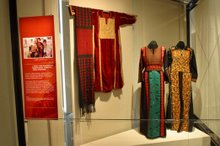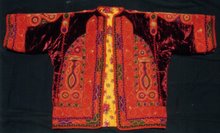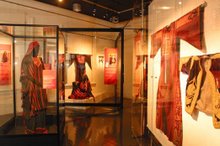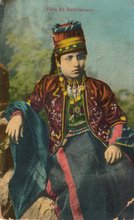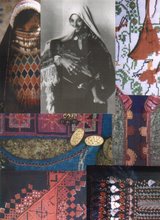 |
| Zar Bakery + Cafe - Musakhan flat bread |
"There are as many recipes for
musakhan chicken as there are cooks"
Way back in 2007 we posted our first "foodie" post, although we didn't know about food blogging at the time. The post was part discussion, part recipe - it featured our "diasporic adaptation" of Musakhan.
Back in 2007 there was very little online about Palestinian cuisine. The post was prompted by our interest in, and mandate to, document modern versions of traditional Palestinian culture. The post began:
 |
The Nassar Family's "Mousakhan with Game Hens"
photo source: Chronicle / Craig Lee
|
"Musakhan ( مسخّن in Arabic) (Palestinian chicken cooked in sumac and onions) recently featured in an American magazine article about a Palestinian Christian family, the Nassars, cooking for Easter. Traditional Musakhan is truly one of the best things you'll ever eat. It's beloved all over the Arab world because it tastes so good. Seriously!
"What interested us about the recipe given in the article is that it provided an interesting example of diasporic adaptation. The Nassar family cooked the dish with game hens rather than chicken, and created individual "musakhan" serves (on small rounds of bread) rather than the traditional "wrapping" in bread. You can see the scrumptious looking results in the photo above.
"We've seen - or eaten - other diasporic versions that incorporate spices like allspice and saffron. This family added paprika. Sumac by the way is a tart lemony flavored spice made from the ground dried berries of a bush that grows wild throughout the Middle East. Boneless chicken versions also exist. Some recipes grill the chicken rather than bake it. Some roast it with onions and then bake it wrapped in bread. The variations are endless but we reckon they probably all taste pretty good.
"We thought we'd share the recipe for Musakhan that our director modified for cooking easily in the West. Our Palestinian great grandmothers would probably observe it with horror but we guarantee it tastes absolutely terrific, and provides an instant comfort food hit for any homesick Palestinian visitors. We are always begging her to make another one. It's incredibly simple to make...."The rest is here. It's still one of our most popular posts and we regularly gets requests for more "diasporic adaptation" recipes. But that was 2007. These days, in 2014, Palestinian cuisine has a much higher profile, with Palestinian restaurants, cook books, food bloggers, fair trade food products, online recipes etc increasing in number and popularity.
Which is all great news. But had Musakhan come along for the ride, we sometimes wondered. Did this much loved dish still exist in 21st century Palestinian homes, whether in Palestine or in the diaspora? It was a terrible thought to think that a whole new generation of Palestinians might be growing up unaware of what is often called Palestine's "national dish".
The answer to this literally turned up on our plate when we visited a new Palestinian restaurant Zar Bakery and Cafe in Canberra a couple of months ago:
 |
| Zar Bakery + Cafe - Musakhan flat bread |
Scoffing Sam's wonderful modern version of Musakhan inspired us.
We went back to the Archive that afternoon thinking an update on our 2007 post was overdue. So over the last couple of weeks - wanting distraction from recent events in Palestine and yet still wanting to comfort ourselves with Palestinian culture - we decided it was time to undertake some research. Time to see what recipes existed online, what Palestinian cookbooks authors and food bloggers had to say about the dish.
So we googled "Musakhan" - and the fun began.
We immediately became aware there was so much more information out there. Back in 2007 Wiki's entry on Musakhan was only a couple of lines. Now these's quite a bit more info, although the entry reads like it's had a lot of different people editing it. It begins:
"Musakhan (Arabic: مسخّن) is a Palestinian dish composed of roasted chicken baked with onions, sumac, allspice, saffron, and fried pine nuts served over taboon bread.
"Palestinian cuisine are similar to the cuisine of Syria—especially in the Galilee. The dishes have been generally influenced by the rule of three major Islamic groups: the Arabs, the Persian-influenced Arabs (Iraqis) and the Ottoman Empire- (Turks).
"The dish is simple to make and the ingredients needed are easily obtainable, which may account for the dish's popularity. Many of the ingredients used: olive oil, sumac and pine nuts are frequently found in Palestinian cuisine.
"Musakhan is a dish that one typically eats with one's hands. It is usually presented with the chicken on top of the bread, and could be served with soup. The term 'musakhan' literally means "something that is heated."See what we mean? What's missing is an actual description of the traditional dish, to say nothing about contemporary versions. One of our favorite descriptions of Musakhan comes from the Desert Candy blog:
"Musakhan, which literally means "warmed," consists of chicken pieces and caramelized onions wrapped up in swaths of of flatbread and baked until the chicken falls off the bone and the bread absorbs all those good chicken juices ... When I once described this dish to a friend, she exclaimed, "bread-wrapped roast chicken, that sounds like a dream!" And indeed, it is excellent. The bread, which is soft and full of chickeny juices on the bottom and crisp and crackly no top, the deep flavor of caramelized onions, the fleck of sumac, the tender meat. It's the sort of weeknight comfort food you can eat all week long.."You need to head over to Wiki's general Palestinian cuisine page to find out more about it's origin:
"Musakhan is a common main dish that originated in the Jenin and Tulkarm area in the northern West Bank. It consists of a roasted chicken over a taboon bread that has been topped with pieces of fried sweet onions, sumac, allspice and pine nuts."
 |
| Middle Eastern Assocation - Musakhan source |
"Classic Palestinian Cookery" author Christiane Dabdoub Nasser agrees with this. Several bloggers who've posted recipes also mention this, but as most don't elaborate we wonder if they picked it up from Wiki. The reason we wonder this is because Wiki's source for this was Institute for Middle East Understanding's "Palestinian Cuisine" page. When you go back and check this, it reads:
"One of the most distinctive Palestinian dishes, said to originate in the Northern West Bank, near Jenin and Tulkarms, is musakhan — roasted chicken smothered in fried onions, pine nuts, and sumac (a dark red, lemony flavored spice), and laid over taboon - a flat bread that takes its name from the free-standing village ovens in which it is baked."Note that "said to originate". We're not saying it didn't - after all Musakhan is a classic example of West Bank cuisine where meals can be "heavy and involve rice, flatbreads and roasted meats" and certainly as the blogger at Middle East Food puts it, "the city of Jenin is very well known for their delicious Musakhan dishes.". It just worth pointing out it would be a nice topic for someone out there interested in this topic to do some further research, hint hint :)
One thing we do know for sure is that Musakhan did not originate amongst bedouin communities. We mention this because some chef authors and bloggers identify Musakhan as a bedouin dish. For examples Greg Malouf describes his dish "Musakhan spicy chicken baked in mountain bread with spinach, chickpeas and pine nuts" in his and Lucy Malouf's book "Saha: a chef's journey through Lebanon and Syria":
"This dish is based on a Bedouin recipe, in which chickens are cooked on bread with lots of sumac and bitter wild greens..."But it's not bedouin. Musakhan is of the felahin, the "peasants" as some writers put it (Clifford Wright: "a favorite dish made by the peasants") from the villages.
 |
| Palestine Costume Archive collection |
A look at it's original ingredients confirms this, with the author of the recipe on WebGaza.net calling a meal of Musakhan "a symbol of self-sufficiency in rural Palestine. Its ingredients are available in any village house at minimum costs, making a delicious and healthy meal." These ingredients, Mai Tamimi (now resident in Otago, New Zealand) observes:
"were readily at hand in the countryside: onions which grew in village gardens, olive oil from the trees around the village, the spice sumac, bread which was made at home, and chickens which foraged around the houses."
"[Musakhan] is usually prepared during the olive oil pressing season to celebrate freshly pressed oil ... Musakhan is all about fresh, simple ingredients allowed to shine. Good olive oil, tangy sumac,a hint of spices, onions caramelized to the point of being sweet and tender, perfectly roasted chicken and fresh bread. Simple yet you have to taste it to see how a dish can be much more than the sum of its parts."
Dima Sharif writes that the dish was:
"originally ... prepared by peasants and farmers to kind of test and celebrate their produce - mainly Olive Oil."Being historically linked to the olive oil harvest meant the dish often appeared at village and family celebrations. Mai Tamimi ("Musakhan was often eaten at celebrations") and Sawsan @ Chef in disguise confirm this, noting how the dish was "usually prepared during the olive oil pressing season to celebrate freshly pressed oil but you can see it on the menu all year round in family gatherings and parties."
 |
| Dima A - Musakhan - Famous chicken dish source |
So has Musakhan survived into the 21st century? Absolutely. We've always felt this was linked to it's simplicity, the quality of it's few ingredients and it's wonderful taste - for Palestinians just the smell of this dish cooking evokes all sorts of memories. So it was nice to find that Palestinian food bloggers felt the same. As Dima Sharif so evocatively writes in her terrific post "Musakhan - the heart of Palestinian cuisine":
"Musakhan is a very simple dish to prepare, that can definately be described as comfort food. For me, Musakhan means Grandma, roots, early childhood, and home. So for me it doesn't get any better"We agree. In contemporary Palestinian and Jordanian homes it is still served as a main dish. However as Syrian Foodie notes, in Syria:
"In Syria, Musakhan is fairly well known and frequently eaten dish although the Syrian version varies a lot from the Palestinian ancestor. The flavours remained the same but the cooking, ingredients and presentation has been refined in keeping with Syrian fondness with food finesse. Here goes thick Taboon bread and comes in paper-thin Saj bread. Chicken is shredded and Musakhan is served in individual portions.
"Musakhan is hardly ever eaten as a main dish in Syria. It is usually served as a side dish or part of a large spread in dinner parties and big family occasions. In coffee shops and restaurants Musakhan is usually served as a small snack dish you can munch on in the few hours you spending there smoking Argeeleh. Another very popular version of Musakhan is tiny small pastries stuffed with the chicken and sumac mixture and served as part of finger food buffet in parties."
 |
| Syrian Foodie source |
"Tiny small pastries" versions of Musakhan would probably have appalled early 20th century Palestinians making the dish, because as Syrian Foodie points out "in it's original format Musakhan is a very rustic dish of layered bread, sumac and onion mixture and roasted chicken." However one thing the Palestinian diaspora has done extremely well is to create almost endless different ways to combine those simple but tasty ingredients of olive oil, bread, sumac, onion and chicken!
We'd noted in our 2007 post:
"We've seen - or eaten - other diasporic versions that incorporate spices like allspice and saffron ... paprika ... Boneless chicken versions also exist. Some recipes grill the chicken rather than bake it. Some roast it with onions and then bake it wrapped in bread. The variations are endless but we reckon they probably all taste pretty good."
 |
| NestleFamily.com source |
Since then a lot more personal recipe variations have appeared. Before we get to those let's look at how ingredients have changed.
Some people keep their ingredients absolutely basic and traditional, sticking with the best quality possible olive oil, bread, chicken and sumac. Christiane Dabdoub Nasser writes in "Classic Palestinian Cookery" that for Musakhan "The key ingredient is the sumac, which you buy as whole grains unless you have a really reliable spice vendor.” Sawsan @ Chef in disguise also stresses it's importance:
"Sumac is one of the main players in Musakhan, it is a spice that comes from the berries of the Rhus shrubs. The berries are dried and then ground to give a purplish deep red powder that is sour, slightly fruity and astringent. It is used in the middle eastern cuisine to add a sour, lemony taste to chicken, salads and salad dressings".
Bread is also a very important component of the dish, as well as an important component of Palestinian cuisine. As we noted in our post about Sam's restaurant Zar Cafe in Canberra:
Traditionally 'Taboon Bread' was used in Musakhan.
"In Canberra we've been used to substituting store-bought pita bread for proper Palestinian bread, and that's a terrible thing. If you've ever tasted home made Palestinian bread you'll understand why. Wiki outlines the different traditional types of bread on their Palestinian cuisine page:
"Palestinians bake a variety of different kinds of breads: they include khubz, pita and markook and taboon. Khubz is an everyday bread and is very similar to pita. It often takes the place of utensils; It is torn into bite size pieces and used to scoop various dips such as hummus or ful. Markook bread is a paper-thin unleavened bread and when unfolded it is almost transparent. Taboon receives its name from the ovens used to bake them."
"But none of this gives you any idea at all of how Palestinian breads taste and smell and feel..."
"Wiki continues: "Traditionally, Levantine women would bake dough in a communal oven in the morning, to provide their family with their daily bread needs, and would prepare smaller portions of dough with different toppings for breakfast at this time. "
"This (either late 19th or early 20th century) photo from the American Colony Collection shows a woman probably from the Jerusalem region, waiting to pick up her bread from her local village oven taboun:
source
Traditionally 'Taboon Bread' was used in Musakhan.
 |
| Musakhan on Taboon bread source - Wiki |
Dima Sharif writes that Taboon Bread was:
"a thick and bubbled bread that peasants used to prepare at home. The bread is supposed to be simple to prepare using the 'Traditional Oven' available at most houses back in the day. They also used to prepare it using their own home-raised chickens that used to run around their front yard ... Although it is ideal to use Taboon Bread, it is not found everywhere; like here in Dubai it is hard to get hold of Taboon Bread, so you can substitute with 'Shrak Bread' a wafer thin bread, found in most supermarkets, and occasionally at lebanese markets."Because the type of bread is so important a lot of bloggers devote time to suggesting other sources. If you plan to try and make this dish - and you should - the advice below might be useful:
- Clifford Wright: "Shrak bread is a thin whole-wheat bread baked on a domed griddle over an open fire, while marquq is a very thin yeasted flat bread. This bread can also be called saj, a bread cooked on a convex metal plate called a surj or saj, hence the name. All of these breads are stretched until very thin before being cooked."
- web gaza: "Taboun bread is the traditional Palestinian bread baked over hot stones. It can be bought at some bakeries and major supermarkets. An adequate replacement is the "Shrak" bread, which is another traditional bread that is extremely thin and baked over a round hot plate."
- Dana at Yummy Halal Recipes: "large loaves of "shrak" bread-the large thin round bread popular here in Jordan"
- Joumana @ Taste of Beirut: "If you are unable to find markook, then you can use phyllo dough. Defrost it in the refrigerator and use about 6 leaves, brushing them with melted butter or a pray, so that they get some flavor. Or, use a couple large pitas, brushing them as well with butter or the fatty chicken broth. Freeze the remaining broth."
- Lins Food: "For most of us, Taboon bread is not easily available, I suggest using any form of flat Middle Eastern bread you have access to; of course baking your own would be perfect. However, for this recipe, I shall assume we are going for shop bought."
- In the US one website suggests: "Shrak bread or tortilla wraps or opened out pitta bread"
- Laila Blogs: " u can use which ever u like ... some people use pitta that is split in half and others use what we call around here iranian bread which is similar to lavash bread … but traditionaly we use bread similar to naan but thinner and its baked in clay oven…"
- The Levantess: "pita or flatbread"
- Dimah at Orange Blossom Water uses "spring roll rappers"
Spring roll wrappers??? Okay, we'll come back to this later lol.
Some chefs / bloggers delete or add new ingredients:
- Just For Licks adds potato: "It is not usually made with potatoes because the bread is so starchy but I love the combination of chicken, onions, and potatoes."
- Middle East Feast made the dish just with onion, with fried chicken served separately
- the Food Spotting blog lists "Mushroom musakhan, leeks, chestnuts, sumac" spotted
- the Nestle Family website adds lemon
- Greg Malouf adds "spinach, chickpeas and pine nuts" in his Saha book recipe. The Deep Dish Dreams blog ate this dish at his restaurant, noting "The first plate we had chosen was Musakhan. Mountain bread shrouds wrapped daintily around subtly spiced quail meat, a paste of chickpeas and shallots. Where once Greg might have used this dish to smack you in the face with cinnamon and baharat - and he would have served it in a pouch - we had a morsel more akin to a lighter, eastern European dumpling in its pared back refinement."
- Syrian Foodie adds "pomegranate Molasses 1 tbsp (my own addition, optional)"
- The Globe and Mail suggests making it with turkey left overs
Quite a few authors and bloggers add additional spices, all of which look interesting:
- Middle East Feast - has lots of interesting spices - "allspice black pepper salt turmeric" and makes the "smac seasoning (optional)"
- Ginger Cream adds "nutmeg cinnamon and black pepper as well as sumac"
- Arabian Mama adds "cumin powder black pepper bay leaves cardamoms all spice"
- Lins Food adds a "clove of garlic"
- Greg Malouf adds
- Dima Sharif adds "garlic Bay Leaves Cloves Cardamon Seeds Black Pepper Black Pepper Juice of 1/2 lemon"
- Mai Tamimi from New Zealand adds "a spice mix of cumin coriander cinnamon 2 Tbsp mild curry powder and black pepper"
- Paula Wolfert adds "nutmeg and cinnamon"
- Web Gaza suggests "To give an interesting taste to the chicken, add cardamom and bay leaves to the water."
Again there are lots of different stories re how the dish was originally cooked. Some prefer the traditional way, baked in a covered dish the oven. Remember Desert Candy's wonderful description:
"Chicken pieces and caramelized onions wrapped up in swaths of of flatbread and baked until the chicken falls off the bone and the bread absorbs all those good chicken juices ... When I once described this dish to a friend, she exclaimed, "bread-wrapped roast chicken, that sounds like a dream!" And indeed, it is excellent. The bread, which is soft and full of chickeny juices on the bottom and crisp and crackly no top, the deep flavor of caramelized onions, the fleck of sumac, the tender meat. It's the sort of weeknight comfort food you can eat all week long.."Clifford Wright's recipe is also a classical version:
" Cover a 9 x 12-inch baking dish with two overlapping halves of the Arabic bread or 2 sheets of marquq bread. Spoon half the onions over each, then arrange the chicken on top of the onions and cover with the remaining onions and the juices from the casserole. Cover with the two remaining half leaves of bread or sheets of marquq bread, tucking in the sides crusty side up. Cover the casserole with aluminum foil. Bake until the chicken is very tender and almost falling off the bone, 1 1/ 2 to 2 hours. Check by sticking a skewer into the chicken and it should glide in easily. If the top bread is getting too crispy, spray with water. Serve hot."
"This simple preparation is one of my favorites and the recipe comes from my former mother-in-law Leila al-Qattan, whose husband Abdul-Muhsin, normally a penetrating dinner conversationalist, loved musakhkhan so much that he never spoke at the table until he was finished."Two other casserole versions:
- We were always told that the dish should be cooked in the oven in a covered dish, casserole style, with bread all around. To serve you took off the bread lid, then served each person bread from the base, onions and chicken. Our 2007 "diasporic adaptation" used this as it's base.
- See also Ginger Cream's recipe
 |
The Nassar Family's "Mousakhan with Game Hens"
photo source: Chronicle / Craig Lee
|
Musakhan Pizza or Musakhan served on flat bread is a very popular way to enjoy the dish. Flat bread dishes like manakeesh are very popular in Palestinian cuisine. We wrote about this in our post about Sam's restaurant Zar Cafe in Canberra:
"Sam creates both the classics and new versions of [Palestinian traditional cuisine]. Here's Sam making manakeesh with za'atar, a very popular Palestinian breakfast dish, although it can be eaten any time ... Here's Sam pressing the dough into a flat bread shape, making little indentations with his fingertips:
"As Wiki points out the word manakeesh: "is the plural of the Arabic word manqūshah (from the root verb naqasha 'to sculpt, carve out'), meaning that after the dough has been rolled flat, it is pressed by the fingertips to create little dips for the topping to lie in...."
"Manakish is popular in most Levantine countries as well as Australia, especially in the major urban centres of Melbourne and Sydney where many Lebanese have settled. In these cities, bakeries selling Manakish are common in predominantly Lebanese areas, often called "Lebanese Pizzas".
"Well some of us called them Palestinian pizzas, but you get the idea. Their topping can be everything from cheese to meat to herbs."It can also be Musakhan - here's Sam's version below hot out of the oven.
 |
| Zar Bakery + Cafe - Musakhan flat bread |
 |
| Zar Bakery + Cafe - Musakhan flat bread |
We can confirm all the lovely lemony peppery sumac-y caramelized onion-y chicken goodness of Musakhan came across in every mouthful.
 |
| Zar Bakery + Cafe - Musakhan flat bread |
So we're converts on the Musakhan Pizza idea :)
 |
| Zar Bakery + Cafe - Musakhan flat bread |
Other Musakhan pizza recipes:
- Middle East Feast (onion pizza with fried chicken on the side)
- Dima Sharif: "I have also offered Musakhan Pizza to my catering clients". You can see a photo of it on Ms Sharif's post :)
- Shobak: Musakhan pizza flatbread
- Jerusalem Restaurant and Catering in Falls Church VA do a nice looking chicken quarter on flat bread
- Chilli and Mint : "A number of the recipes for this dish talk about the sumac chicken and onions (and sometimes also allspice and saffron!) on a flat bread that then gets toasted and scattered with toasted pine nuts, but I thought I would create the dish in a wrap form to make it easier to pick up and eat. I leave it to you to consume in either the flat or rolled form, both will be equally delicious I assure you."
- Dima Sharif: "I remember, many years ago, I decided to serve Musakhan in rolls to reduce the mess and to make for a more elegant presentation. Nowadays, Musakhan Rolls are a staple snack and party item"
- Docaitta - Musakhan Chicken Wraps
- Dana at Yummy Halal Recipes - Musakhan Wraps
- Nestle Family - Chicken Musakhan
- Taste of Beirut - wrapped in thin pita
- Syrian Foodie - Musakhan in baked crisp pastry rolls
- Laila Blogs - Musakhan Chicken dish ("roll it all tightly .. Then place it a baking tray .. and bake until golden from down and up …")
- Savoury Table A Denver area food and recipe blog - The Chicken Musakhan Sandwich for open sandwich / taco style
- Orange Blossom Water - makes spring rolls
 |
| QueenRania - Twitter Our Friday family lunch today...delicious Musakhan source |
Have we convinced you on the fact that Musakhan is still popular? If not, here's two final facts to make you smile. First, above is Queen Rania's Twitter photo of "Our Friday family lunch today...delicious Musakhan", so royalty still enjoys it. And finally, did you know Musakhan is in the Guinness Book of Records?
 |
| AFP source |
From Wiki's Musakhan page:
"On April 20, 2010, the largest ever dish of Musakhan was prepared in Ramallah, Palestine and entered it into the Guinness Book of World Records. Palestinian Prime Minister, Salam Fayad, described it as a great achievement and honor for the Palestinian people: "This great achievement completely depended on Palestinian products, mainly olive oil. It also has a cultural dimension and a Palestinian message to the world that they want their legitimate rights."
"The total diameter of the 'Musakhan' loaf was 4 meters, with a total weight of 1,350 kg. Forty Palestinian cooks made use of 250 kg of flour, 170 kg of olive oil, 500 kg of onions and 70 kg of almond."Sadly Wiki doesn't mention the 500 chickens.
 |
| source |
We think Musakhan is safe from vanishing for a few generations yet. It may look different to classical Musakhan in early 20th century Palestinian kitchens, but this magical dish remains, in Dima Sharif words "the heart of Palestinian cuisine".
References:
- Wiki - musakhan
- Wiki - taboon bread
- Wiki - Palestinian cuisine
- Institute for Middle East Understanding's "Palestinian Cuisine" page
- Dima Sharif - "Musakhan - the heart of Palestinian cuisine":
- Arva @ I Live in a Frypan attended Dima Sharif's "Cook the Books" event and wrote a very thoughtful, beautifully written post about the night, titled "When lentils, nuts and olive oil are not just food, but stories of Palestine":
- Dima Sharif - "Musakhan - the heart of Palestinian cuisine"
- Sawsan@ Chef in disguise
- Syrian Foodie - Syrian style Musakhan
- Clifford Wright
- Desert Candy
- Dana at Yummy Halal Recipes
- Joumana @ Taste of Beirut - 1) Palestinian chicken wraps and 2) Chicken with bread and onion and sumac
- Taste of Beirut
- Just For Licks
- Laila Blogs
- Ginger Cream
- WebGaza.net
- Lins Food
- Arabian Mama
- Middle East Food
- Middle East Feast
- Doccaitta
- Orange Blossom Water
- The Levantress
- Canadian Arab Community - recipes
- Stovetop Solutions
- Nestle Family
- Greg Malouf
- Paula Wolfert
- Food Spotting
- Canaan Fair Trade

















































